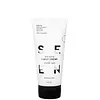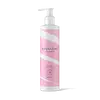What's inside
What's inside
 Key Ingredients
Key Ingredients

 Benefits
Benefits

 Concerns
Concerns

 Ingredients Side-by-side
Ingredients Side-by-side

Water
Skin ConditioningCetearyl Alcohol
EmollientC13-15 Alkane
SolventGlycerin
HumectantShea Butter Cetyl Esters
Skin ConditioningSqualane
EmollientBehentrimonium Chloride
PreservativeHydrolyzed Ceratonia Siliqua Seed Extract
Skin ConditioningZea Mays Starch
AbsorbentMoringa Oleifera Seed Extract
Skin ConditioningBisabolol
MaskingGuar Hydroxypropyltrimonium Chloride
Skin ConditioningTocopherol
AntioxidantPolyquaternium-7
Disodium EDTA
Vp/Va Copolymer
Disodium Phosphate
BufferingCitric Acid
BufferingPhenoxyethanol
PreservativeEthylhexylglycerin
Skin ConditioningSodium Benzoate
MaskingPotassium Sorbate
PreservativeWater, Cetearyl Alcohol, C13-15 Alkane, Glycerin, Shea Butter Cetyl Esters, Squalane, Behentrimonium Chloride, Hydrolyzed Ceratonia Siliqua Seed Extract, Zea Mays Starch, Moringa Oleifera Seed Extract, Bisabolol, Guar Hydroxypropyltrimonium Chloride, Tocopherol, Polyquaternium-7, Disodium EDTA, Vp/Va Copolymer, Disodium Phosphate, Citric Acid, Phenoxyethanol, Ethylhexylglycerin, Sodium Benzoate, Potassium Sorbate
Water
Skin ConditioningCetearyl Alcohol
EmollientCocos Nucifera Oil
MaskingGlycerin
HumectantDiheptyl Succinate
EmollientBis-(Isostearoyl/Oleoyl Isopropyl) Dimonium Methosulfate
Skin ConditioningCoco-Caprylate
EmollientCocos Nucifera Fruit Extract
EmollientDistearoylethyl Dimonium Chloride
Capryloyl Glycerin/Sebacic Acid Copolymer
Skin ConditioningBenzyl Alcohol
PerfumingGuar Hydroxypropyltrimonium Chloride
Skin ConditioningAleurites Moluccanus Seed Oil
Skin ConditioningButyrospermum Parkii Butter
Skin ConditioningCitrus Grandis Peel Oil
MaskingCitrus Nobilis Peel Oil
MaskingCitrus Aurantium Bergamia Fruit Oil
MaskingCitrus Aurantium Dulcis Peel Oil
MaskingOriganum Majorana Leaf Oil
MaskingMichelia Alba Leaf Oil
MaskingRosmarinus Officinalis Leaf Oil
MaskingDehydroacetic Acid
PreservativePogostemon Cablin Leaf Oil
MaskingPentylene Glycol
Skin ConditioningMentha Viridis Leaf Oil
AstringentStyrax Tonkinensis Resin Extract
PerfumingCymbopogon Martini Oil
MaskingMichelia Alba Flower Oil
MaskingLitsea Cubeba Fruit Oil
MaskingTilia Cordata Flower Extract
Skin ConditioningHydrogenated Vegetable Oil
EmollientTocopherol
AntioxidantCitric Acid
BufferingLimonene
PerfumingLinalool
PerfumingGeraniol
PerfumingBenzyl Benzoate
AntimicrobialCitral
PerfumingWater, Cetearyl Alcohol, Cocos Nucifera Oil, Glycerin, Diheptyl Succinate, Bis-(Isostearoyl/Oleoyl Isopropyl) Dimonium Methosulfate, Coco-Caprylate, Cocos Nucifera Fruit Extract, Distearoylethyl Dimonium Chloride, Capryloyl Glycerin/Sebacic Acid Copolymer, Benzyl Alcohol, Guar Hydroxypropyltrimonium Chloride, Aleurites Moluccanus Seed Oil, Butyrospermum Parkii Butter, Citrus Grandis Peel Oil, Citrus Nobilis Peel Oil, Citrus Aurantium Bergamia Fruit Oil, Citrus Aurantium Dulcis Peel Oil, Origanum Majorana Leaf Oil, Michelia Alba Leaf Oil, Rosmarinus Officinalis Leaf Oil, Dehydroacetic Acid, Pogostemon Cablin Leaf Oil, Pentylene Glycol, Mentha Viridis Leaf Oil, Styrax Tonkinensis Resin Extract, Cymbopogon Martini Oil, Michelia Alba Flower Oil, Litsea Cubeba Fruit Oil, Tilia Cordata Flower Extract, Hydrogenated Vegetable Oil, Tocopherol, Citric Acid, Limonene, Linalool, Geraniol, Benzyl Benzoate, Citral
Ingredients Explained
These ingredients are found in both products.
Ingredients higher up in an ingredient list are typically present in a larger amount.
Cetearyl alcohol is a mixture of two fatty alcohols: cetyl alcohol and stearyl alcohol. It is mainly used as an emulsifier. Emulsifiers help prevent the separation of oils and products. Due to its composition, it can also be used to thicken a product or help create foam.
Cetearyl alcohol is an emollient. Emollients help soothe and hydrate the skin by trapping moisture.
Studies show Cetearyl alcohol is non-toxic and non-irritating. The FDA allows products labeled "alcohol-free" to have fatty alcohols.
This ingredient is usually derived from plant oils such as palm, vegetable, or coconut oils. There is debate on whether this ingredient will cause acne.
Due to the fatty acid base, this ingredient may not be Malassezia folliculitis safe.
Learn more about Cetearyl AlcoholCitric Acid is an alpha hydroxy acid (AHA) naturally found in citrus fruits like oranges, lemons, and limes.
Like other AHAs, citric acid can exfoliate skin by breaking down the bonds that hold dead skin cells together. This helps reveal smoother and brighter skin underneath.
However, this exfoliating effect only happens at high concentrations (20%) which can be hard to find in cosmetic products.
Due to this, citric acid is usually included in small amounts as a pH adjuster. This helps keep products slightly more acidic and compatible with skin's natural pH.
In skincare formulas, citric acid can:
While it can provide some skin benefits, research shows lactic acid and glycolic acid are generally more effective and less irritating exfoliants.
Most citric acid used in skincare today is made by fermenting sugars (usually from molasses). This synthetic version is identical to the natural citrus form but easier to stabilize and use in formulations.
Read more about some other popular AHA's here:
Learn more about Citric AcidGlycerin is already naturally found in your skin. It helps moisturize and protect your skin.
A study from 2016 found glycerin to be more effective as a humectant than AHAs and hyaluronic acid.
As a humectant, it helps the skin stay hydrated by pulling moisture to your skin. The low molecular weight of glycerin allows it to pull moisture into the deeper layers of your skin.
Hydrated skin improves your skin barrier; Your skin barrier helps protect against irritants and bacteria.
Glycerin has also been found to have antimicrobial and antiviral properties. Due to these properties, glycerin is often used in wound and burn treatments.
In cosmetics, glycerin is usually derived from plants such as soybean or palm. However, it can also be sourced from animals, such as tallow or animal fat.
This ingredient is organic, colorless, odorless, and non-toxic.
Glycerin is the name for this ingredient in American English. British English uses Glycerol/Glycerine.
Learn more about GlycerinThis ingredient is derived from guar gum.
It is a conditioning ingredient, meaning it helps soften skin and hair.
Tocopherol (also known as Vitamin E) is a common antioxidant used to help protect the skin from free-radicals and strengthen the skin barrier. It's also fat soluble - this means our skin is great at absorbing it.
Vitamin E also helps keep your natural skin lipids healthy. Your lipid skin barrier naturally consists of lipids, ceramides, and fatty acids. Vitamin E offers extra protection for your skin’s lipid barrier, keeping your skin healthy and nourished.
Another benefit is a bit of UV protection. Vitamin E helps reduce the damage caused by UVB rays. (It should not replace your sunscreen). Combining it with Vitamin C can decrease sunburned cells and hyperpigmentation after UV exposure.
You might have noticed Vitamin E + C often paired together. This is because it is great at stabilizing Vitamin C. Using the two together helps increase the effectiveness of both ingredients.
There are often claims that Vitamin E can reduce/prevent scarring, but these claims haven't been confirmed by scientific research.
Learn more about TocopherolWater. It's the most common cosmetic ingredient of all. You'll usually see it at the top of ingredient lists, meaning that it makes up the largest part of the product.
So why is it so popular? Water most often acts as a solvent - this means that it helps dissolve other ingredients into the formulation.
You'll also recognize water as that liquid we all need to stay alive. If you see this, drink a glass of water. Stay hydrated!
Learn more about Water